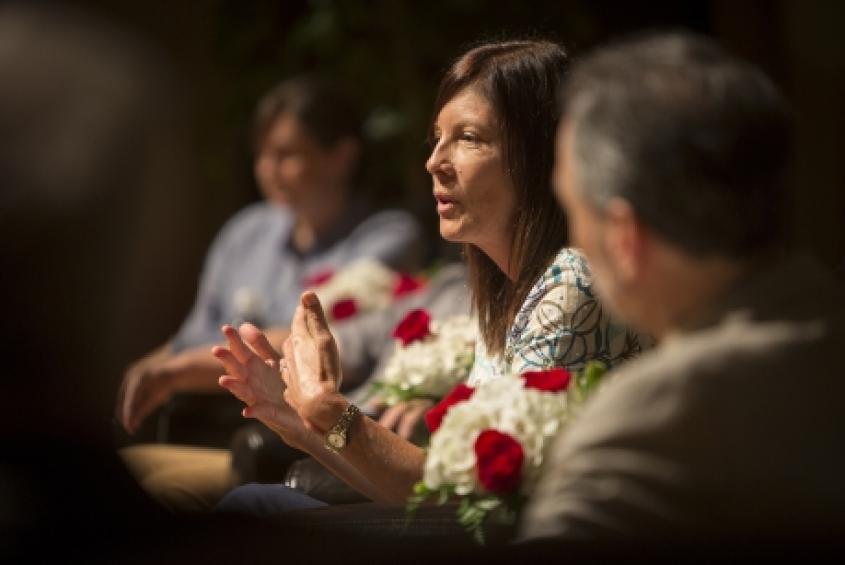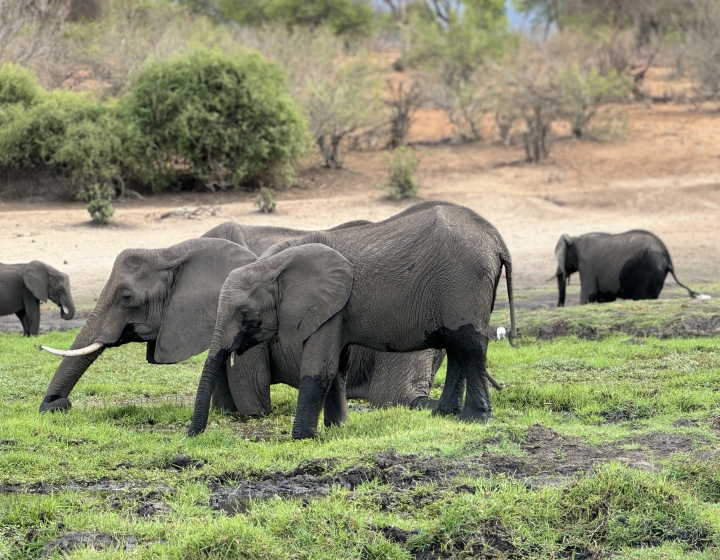Wildlife Health Cornell takes new approach to natural world
Wildlife ecologist Shirley Atkinson speaks at the Reunion Weekend 2017 panel "Wildlife Health Cornell: Because We Need Nature, and Nature Needs Us" in Statler Auditorium.
We need nature – and nature needs us. It’s a novel approach to wildlife conservation and the founding principle of a new initiative from the College of Veterinary Medicine. Led by some of the world’s top wildlife health experts, Wildlife Health Cornell seeks a healthier future for wildlife by promoting the well-being of animals, people and the natural world we share.
A Reunion Weekend panel June 9, co-sponsored by the College of Veterinary Medicine and the David R. Atkinson Center for a Sustainable Future, introduced Wildlife Health Cornell and four members of its research and policy team: Steven Osofsky, Martin Gilbert, Shirley Atkinson and Beth Bunting, from Cornell’s Department of Population Medicine and Diagnostic Sciences. More than 100 Cornell alumni, staff and veterinary students attended the session at Statler Auditorium.
After an introduction by Provost Michael Kotlikoff, the session showcased conservation research and field experiences from the Wildlife Health Cornell team. Osofsky and Bunting are Atkinson Center faculty fellows. Osofsky and Atkinson (with Randy Worobo, professor of food science) recently received an Academic Venture Fund grant for research in Botswana to test new guidelines for biosafety in beef production that rely on practical risk mitigation steps, instead of habitat-disrupting fences.
Osofsky described ongoing efforts to stop a “slow-motion environmental train wreck” in southern Africa, where massive fences built to protect livestock from foot-and-mouth disease had the unintended consequence of cutting off seasonal wildlife migration routes. Now eco-tourism rivals the beef industry as a source of livelihoods, and researchers are working with government agencies and local people to recreate wildlife corridors, while finding new ways to promote safe beef exports.
Atkinson stressed building trust and bringing people to the table to mend the historical rift between the wildlife conservation and livestock sectors. “We used health as the entry point – not disease,” she said, “to talk about ensuring the health of people and livelihoods and building a healthy environment so that wildlife and cattle can thrive.”
Gilbert discussed his work tracking an epidemic of canine distemper killing large cats in the Russian far east. Researchers discovered that a modified live virus is effective and safe in zoo tigers. Vaccinating these rare and wary animals in the wild is the real challenge, but with only 400 tigers left in the Russian forest, he said, “vaccinating even a couple of tigers a year could be enough to head off extinction.”
Bunting has been working with New York State’s Department of Environmental Conservation since 2010 to build a comprehensive wildlife health program. “Managing game used to be the state’s top priority,” she said. “Now disease in wildlife is one of our most important public health issues.” She described how lead from hunters’ ammunition can move from game into the human food supply, and even into threatened species like bald eagles that scavenge lead-tainted meat.
Questions from attendees – including many veterinary college alumni and students – explored the contributions veterinarians can make to public and environmental health and highlighted links between clinical work and public policy.
Osofsky noted the important role Cornell veterinary graduates, as respected professionals in their communities, can play in expanding understanding of the relationships between the health of domestic animals and wildlife, human health and stewardship of the environment. “Veterinarians are perfect ambassadors for planetary health,” he said.
Sheri Englund is the Atkinson Center’s science writer and editor.
This article originally appeared in the Cornell Chronicle






